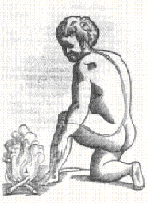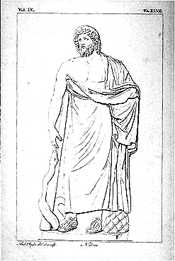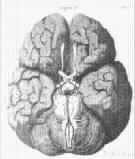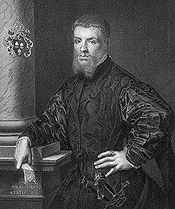 |
Milestones in Neuroscience Research |
 |
| Some of the best references for the events that document the history of the neurosciences are:
- Afifi, A.K. and Bergman, R.A., Functional Neuroanatomy, New York: McGraw-Hill, 1998. The margins of this text are filled with historical facts about the origins of neuroanatomical structures and discoveries.
- Bennett, M.R., The early history of the synapse: From Plato to Sherrington, Brain Research Bulletin, 50:95-118, 1999.
- Brazier, M.A.B., A History of the Electrical Activity of the Brain, London: Pitman, 1961.
- Brazier, M.A.B., A History of Neurophysiology in the 19th Century, New York: Raven Press, 1988.
- Clarke, E. and Dewhurst, K., An Illustrated History of Brain Function, Berkeley: University of California Press, 1972.
- Clarke, E. and C.D. O'Malley, C.D., The Human Brain and Spinal Cord, Berkeley: University of California Press, 1968.
- Finger, S., Origins of Neuroscience, New York: Oxford University Press, 1994.
- Finger, S. Minds Behind the Brain: A History of the Pioneers and Their Discoveries, New York: Oxford University Press, 2000.
- Francis, R.L., The Illustrated Almanac of Science Technology and Invention, New York: Plenum Press, 1997.
- Gross, C.G., Brain, Vision, Memory. Tales in the History of Neuroscience, Cambridge, MIT Press, 1998.
- Harding, A.S., Milestones in Health and Medicine, Phoenix (AZ) Oryx Press, 2000.
- Kandel, E.R. and Squire, L.R., Neuroscience: Breaking Down Scientific Barriers to the Study of Brain and Mind, in Science, 290:1113-1120, 2000.
- Marshall, L.H. and Magoun, H.W., Discoveries in the Human Brain, Totowa; Humana Press, 1998.
- Martensen, R.L., The Brain Takes Shape. An Early History, New York: Oxford University Press, Inc., 2004.
- Millon, T., Masters of the Mind. Exploring the Story of Mental Illness from Ancient Times to the New Millennium, Hoboken (NJ): John Wiley and Sons, 2004.
- Rose, F.C. and Bynum, W.F., Historical Aspects of the Neurosciences. A Festschrift for Macdonald Critchely, New York: Raven Press, 1982.
- Sebastian, A. Dates in Medicine. A Chronological Record of Medical Progress Over Three Millennia, New York: The Parthenon Publishing Group, 2000
- Shepherd, G.M., Foundations of the Neuron Doctrine, New York: Oxford University Press, 1991.
- Swartz, B.E. and Goldenshon, E.S., Timeline of the history of EEG and associated fields, Electroenceph. Clin. Neurophysiol., 106:173-176, 1998.
|

Image courtesy of the National Library of Medicine |
The following dates and events were gathered from several sources. These events are certainly not all of the important events to take place in neuroscience...just some of the ones that I have selected.
|
[NextPage]
4000 B.C. to 0 A.Dca. 4000 B.C. - Euphoriant effect of poppy plant reported in Sumerian records
ca. 4000 B.C. - Clay tablets from Mesopotamia discuss how to use alcohol to dilute medicine
ca. 2700 B.C. - Shen Nung originates acupuncture
ca. 1700 B.C. - Edwin Smith surgical papyrus written. First written record about the nervous system
ca. 500 B.C. - Alcmaion of Crotona dissects sensory nerves
ca. 500 B.C. - Alcmaion of Crotona describes the optic nerve
460-379 B.C. - Hippocrates discusses epilepsy as a disturbance of the brain
460-379 B.C. - Hippocrates states that the brain is involved with sensation and is the seat of intelligence
387 B.C. - Plato teaches at Athens. Believes brain is seat of mental process
335 B.C. - Aristotle writes about sleep; believes heart is seat of mental process
335-280 B.C. - Herophilus (the "Father of Anatomy"); believes ventricles are seat of human intelligence
280 B.C. - Erasistratus of Chios notes divisions of the brain
|

Hippocrates
Image courtesy of the Blocker History of Medicine Collections, Moody Medical Library, Univ. Texas Med. Branch, Galveston |
0 A.D. to 1500177 - Galen lecture "On the Brain"
ca. 100 - Marinus describes the tenth cranial nerve
ca. 100 - Rufus of Ephesus describes and names the optic chiasm.
ca. 1000 - Alhazen compares the eye to a camera-like device
1316 - Mondino de'Luzzi writes the first European anatomy textbook (Anothomia)
1402 - St. Mary of Bethlehem Hospital is used exclusively for the mentally ill
1410 - Institution for the mentally ill established in Valencia, Spain
|

Image courtesy of the National Library of Medicine,
History of Medicine Collection |
1500 - 16001504 - Leonardo da Vinci produces wax cast of human ventricles
1536 - Nicolo Massa describes the cerebrospinal fluid
1538 - Andreas Vesalius publishes Tabulae Anatomicae
1543 - Andreas Vesalius publishes "On the Workings of the Human Body"
1543 - Andreas Vesalius discusses pineal gland and draws the corpus striatum
1550 - Vesalius describes hydrocephalus
1550 - Bartolomeo Eustachio describes the brain origin of the optic nerves
1561 - Gabriele Falloppio publishes "Observationes Anatomicae" and describes some of the cranial nerves. Separate trochlear and abducens nerves identified
1562 - Bartolomeo Eustachio publishes "The Examination of the Organ of Hearing"
1564 - Aranzi coins the term "hippocampus"
1573 - Constanzo Varolio names the pons
1573 - Constanzo Varolio is first to cut brain starting at its base
1573 - Girolamo Mercuriali writes De nervis opticis to describe optic nerve anatomy
1583 - Felix Platter states that the lens only focuses light and that the retina is where images are formed
1586 - A. Piccolomini distinguishes between cortex and white matter
1587 - Giulio Cesare Aranzi describes ventricles and hippocampus. He also demonstrates that the retina has a reversed image
1590 - Zacharias Janssen invents the compound microscope
1596 - Sir Walter Raleigh mentions arrow poison in his book Discovery of the Large, Rich and Beautiful Empire of Guiana
|

Leonardo Da Vinci

Andreas Vesalius
Image courtesy of the Blocker History of Medicine Collections, Moody Medical Library, Univ. Texas Med. Branch, Galveston |
1600 - 17001604 - Johannes Kepler describes inverted retinal image
1609 - J. Casserio publishes first description of mammillary bodies
1611 - Lazarus Riverius textbook describing impairments on consciousness published
1621 - Robert Burton publishes The Anatomy of Melancholy about depression
1623 - Benito Daca de Valdes publishes the first book on vision testing and eyeglass-fitting
1641 - Franciscus de la Boe Sylvius describes fissure on the lateral surface of the brain (Sylvian fissure)
1649 - Rene Descartes describes pineal as control center of body and mind
1650 - Franciscus de la Boe Sylvius describes a narrow passage between the third and fourth ventricles (the aqueduct of Sylvius)
1658 - Johann Jakof Wepfer theorizes that a broken brain blood vessel may cause apoplexy (stroke)
1661 - Thomas Willis describes a case of meningitis
1662 - Rene Descartes "De homine" is published (He died in 1650)
1664 - Thomas Willis publishes "Cerebri anatome" (in Latin)
1664 - Thomas Willis describes the eleventh cranial nerve (accessory nerve)
1664 - Gerardus Blasius discovers and names the "arachnoid"
1665 - Robert Hooke details his first microscope
1667 - Robert Hooke publishes "Micrographia"
1668 - l'Abbe Edme Mariotte discovers the blind spot
1670 - William Molins names the trochlear nerve
1673 - Joseph DuVerney uses experimental ablation technique in pigeons
1681 - English edition of Thomas Willis' "Cerebri anatome" was published
1681 - Thomas Willis coins the term Neurology
1684 - Raymond Vieussens publishes "Neurographia Universalis"
1684 - Raymond Vieussens uses boiling oil to harden the brain
1686 - Thomas Sydenham describes a form of chorea in children and young adults
1695 - Humphrey Ridley describes the restiform body
1695 - Humphrey Ridley publishes "The Anatomy of the Brain"
1696 - John Locke writes "Essay Concerning Human Understanding"
1697 - Joseph G. Duverney introduces the term "brachial plexus"
| (责任编辑:泉水)
|